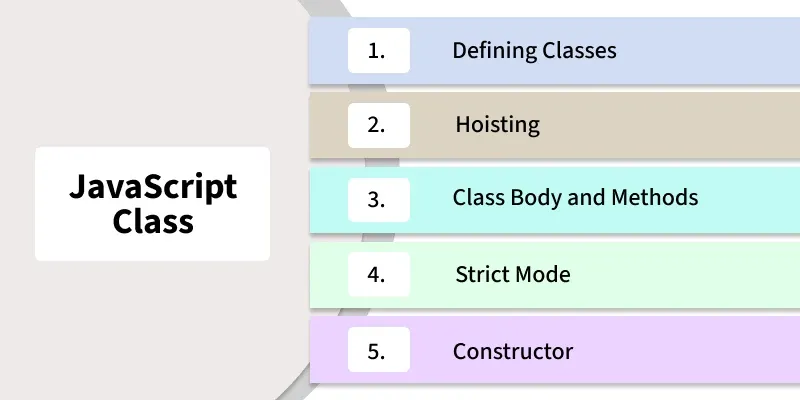JavaScript classes (introduced in ES6) provide a structured way to create objects with shared properties and methods. They support inheritance, encapsulation, and modularity, making it easier to write object-oriented code.
 Javascript Class
Javascript ClassSyntax
class ClassName {
constructor() {
// Initialize properties here
}
// Define methods here
methodName() {
// Method code
}
}- The class keyword is used to declare a class.
- The constructor() method is a special method that is automatically called when an instance of the class is created.
- You can define methods inside the class to provide behaviour for objects created from the class.
Key Features of JavaScript Classes
- Encapsulation: Bundles data (properties) and behaviour (methods) together.
- Constructor Method: Initializes properties when an object is created.
- Inheritance: Allows one class to inherit properties and methods from another.
- Code Reusability: Enables the creation of multiple instances with shared functionality.
- Simplicity & Clarity: Provides a clear structure for creating and managing objects.
Creating a Simple Class
A basic class that defines properties and methods. This example shows how to create an object with a constructor and method.
JavaScript class Person { constructor(name, age) { this.name = name; this.age = age; } g() { console.log(`Hello, my name is ${this.name} and I am ${this.age} years old.`); } } let p1 = new Person("Pranjal", 20); p1.g(); OutputHello, my name is Pranjal and I am 20 years old.
- The Person class has a constructor to set name and age, and a g method to log a greeting message.
- An instance (p1) is created with new, passing "Pranjal" and 20, then calls g to print the greeting.
Constructor to Initialize Objects
The constructor is used to initialize the properties of the object when an instance is created.
JavaScript class Car { constructor(make, model, year) { this.make = make; this.model = model; this.year = year; } d() { console.log(`${this.year} ${this.make} ${this.model}`); } } let my = new Car("Toyota", "Corolla", 2021); my.d(); Output2021 Toyota Corolla
- The Car class has a constructor to initialize make, model, and year, and a d method to log the car's details.
- An instance (my) is created with new, passing "Toyota", "Corolla", and 2021, then calls d to print the car's information.
Inheritance in Classes
Inheritance allows one class to extend another, inheriting its properties and methods while adding or overriding functionality.
JavaScript class Car { constructor(make, model, year) { this.make = make; this.model = model; this.year = year; } di() { console.log(`${this.year} ${this.make} ${this.model}`); } } class ElectricCar extends Car { constructor(make, model, year, batteryLife) { super(make, model, year); this.batteryLife = batteryLife; } d() { console.log(`Battery life: ${this.batteryLife} hours`); } } let tesla = new ElectricCar("Tesla", "Model S", 2022, 24); tesla.di() tesla.d(); Output2022 Tesla Model S Battery life: 24 hours
- ElectricCar inherits from Car, using super to set properties and adds batteryLife and d method.
- An instance (tesla) calls both di to display car details and d to show battery life.
Creating Multiple Objects from a Class
Using classes to create multiple objects with the same structure but different data.
JavaScript class Car { constructor(make, model, year) { this.make = make; this.model = model; this.year = year; } d() { console.log(`${this.year} ${this.make} ${this.model}`); } } let c1 = new Car("Toyota", "Corolla", 2021); let c2 = new Car("Honda", "Civic", 2020); c1.d(); c2.d(); Output2021 Toyota Corolla 2020 Honda Civic
- The Car class initializes car details and has a d method to display them.
- Two Car instances (c1 and c2) are created, and d is called on both to show their details.
Explore
JavaScript Basics
Array & String
Function & Object
OOP
Asynchronous JavaScript
Exception Handling
DOM
Advanced Topics
My Profile